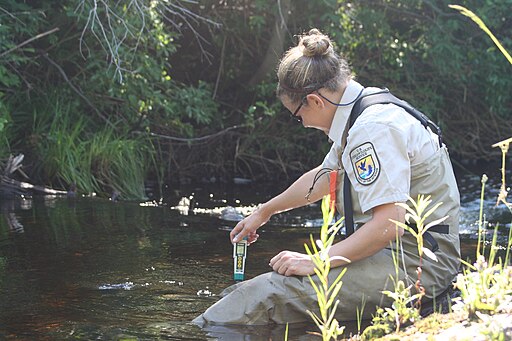The National Pollutant Discharge Elimination System (NPDES) Permit is issued by either EPA or an authorized state to all facilities that discharge any pollutant into Waters of the United States. It is important for all operators to know the basics of what is on your system’s permit and to understand how meeting the requirements—and not meeting requirements—affects the environment.

Photo credit: U.S. Fish and Wildlife Service – Midwest Region, Public domain, via Wikimedia Commons
Permit Basics
Your NPDES permit will contain information on what and how much your system can discharge. It will also inform you of all monitoring and reporting requirements. All sampling data will be placed on a DMR (Discharge Monitoring Report) and sent to EPA. The permit will specify where to take samples, which is usually at the point of discharge. For each sampling parameter, the permit will specify whether grab or composite samples are needed.
Common sampling parameters include:
- Flow rate and pH, recorded at the interval stated on your permit (could be daily, monthly, etc.)
- Biochemical Oxygen Demand (BOD), Total Suspended Solids (TSS) daily and monthly averages
- E. Coli or Fecal Coliform
- Phosphorus, Total Nitrogen, Fats/Oils/Grease (FOG), Ammonia and Turbidity
Each permit will have its own specific parameters. A specific discharge point with GPS coordinates, pictures and the name of the area will likely be included in the permit. This will be typically by the effluent wastewater sampling point. Sometimes the end of the pipe discharge point is too hard to access for sampling purposes. In that case, you can use a predetermined point after disinfection at the treatment plant.
The EPA no longer accepts paper reports sent via certified mail. Here’s how to send your monthly discharge permit report to EPA:
- A NetDMR (Net Discharge Monitoring Report) account must be set up by each reporting system. This portal is administered by EPA and makes it easier to insert lab data into the template.
- The portal system will confirm delivery of reports and makes it easier to make changes if needed.
- The portal is also used for permit renewal. Be sure to submit renewal applications 180 days before your current permit expires. This will give EPA time to ask questions or request more data and information.
- For more information in EPA’s portal, visit the EPA NetDMR FAQ webpage.
For state-specific requirements, please contact your state’s environmental quality agency. The EPA provides links to state resources here: https://www.epa.gov/npdes/npdes-state-program-authority
Use or disposal of Sewage Sludge Biosolids
The Clean Water Act Part 503 regulates pollutants that might be present in sewage sludge biosolids. Part 503 requires annual reports be submitted by treatment works that land apply, incinerate or surface dispose of their biosolids. A separate annual report will be submitted with data about your biosolids when composting and land applying. This website on EPA’s guidance for biosolids will provide systems with more information regarding all items needed for sampling, reporting and parameters to follow.
The EFCN is here to help!
If you would like assistance with or have questions about meeting your NPDES permit requirements to stay in compliance, we are here to help. Contact us at: https://efcnetwork.org/get-help/

